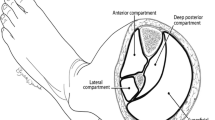Abstract
Advances in computed tomography (CT) angiography have increased the sensitivity and specificity of detecting small branch arterial injuries in the extremities of trauma patients. However, it is unclear whether these patients should undergo surgery, angioembolization, or conservative watchful waiting. We hypothesized that uncomplicated small arterial branch injuries can be managed successfully with watchful waiting. A 10-year retrospective review of extremity CT angiograms with search findings of arterial “active extravasation” or “pseudoaneurysm” was performed at a level 1 county trauma center. Subgroup analysis was performed on those with isolated extremity injury and those with concurrent injuries. A total of 31 patients had CT-detected active extravasation (84 %) or pseudoaneurysm (16 %), 71 % of which were isolated vascular injuries. Of the patients evaluated, 71 % (n = 22) were managed with watchful waiting, 19 % (n = 6) with angioembolization, and 10 % (n = 3) with surgery. Watchful waiting complications included progression to alternative treatment (n = 1) and blood transfusions (n = 2). Complications of surgery included the inability to find active bleeding (n = 1) and postoperative psychosis (n = 1). Complications of angioembolization were limited to a postprocedure blood transfusion (n = 1). Patients with isolated vascular injuries had an average length of stay of 2.9 days, with management averages of the following: 2.7 days with watchful waiting (n = 16), 3.3 days with angioembolization (n = 3), and 3.7 days with surgery (n = 3). CT angiography has greatly increased the reported incidence of traumatic arterial injury in the extremity. We propose that small branch arterial injuries in the extremities can be managed successfully with watchful waiting and do not often require immediate embolization.


Similar content being viewed by others
References
Franz RW, Shah KJ, Halaharvi D, Franz ET, Hartman JF, Wright ML (2011) A 5-year review of management of lower extremity arterial injuries at an urban level I trauma center. J Vasc Surg 6:1604–1610
Hafez HM, Woolgar J, Robbs JV (2001) Lower extremity arterial injury: results of 550 cases and review of risk factors associated with limb loss. J Vasc Surg 6:1212–1219
Berg RJ, Okoye O, Inaba K, Konstantinidis A, Branco B, Meisel E, Barmparas G, Demetriades D (2012) Extremity firearm trauma: the impact of injury pattern on clinical outcomes. Am Surg 12:1383–1387
Rozycki GS, Tremblay LN, Feliciano DV, McClelland WB (2003) Blunt vascular trauma in the extremity: diagnosis, management, and outcome. J Trauma 5:814–824
Kauvar DS, Sarfati MR, Kraiss LW (2011) National trauma databank analysis of mortality and limb loss in isolated lower extremity vascular trauma. J Vasc Surg 6:1598–1603
Franz RW, Skytta CK, Shah KJ, Hartman JF, Wright ML (2012) A five-year review of management of upper-extremity arterial injuries at an urban level I trauma center. Ann Vasc Surg 5:655–664
Bechara C, Huynh TT, Lin PH (2007) Management of lower extremity arterial injuries. J Cardiovasc Surg (Torino) 5:567–579
Franz RW, Goodwin RB, Hartman JF, Wright ML (2009) Management of upper extremity arterial injuries at an urban level I trauma center. Ann Vasc Surg 1:8–16
Frykberg ER, Dennis JW, Bishop K, Laneve L, Alexander RH (1991) The reliability of physical examination in the evaluation of penetrating extremity trauma for vascular injury: results at one year. J Trauma 4:502–511
Doody O, Given MF, Lyon SM (2008) Extremities—indications and techniques for treatment of extremity vascular injuries. Injury 11:1295–1303
Maleux G, Herten PJ, Vaninbroukx J, Thijs M, Nijs S, Fourneau I, Heye S (2012) Value of percutaneous embolotherapy for the management of traumatic vascular limb injury. Acta Radiol 2:147–152
Parodi JC, Schönholz C, Ferreira LM, Bergan J (1999) Endovascular stent-graft treatment of traumatic arterial lesions. Ann Vasc Surg 2:121–129
Beregi JP, Prat A, Willoteaux S, Vasseur MA, Boularand V, Desmoucelle F (1999) Covered stents in the treatment of peripheral arterial aneurysms: procedural results and midterm follow-up. Cardiovasc Intervent Radiol 1:13–19
Carrafiello G, Laganà D, Mangini M, Fontana F, Chiara R, Filippo P, Carlo P, Piffaretti G, Fugazzola C (2011) Percutaneous treatment of traumatic upper-extremity arterial injuries: a single-center experience. J Vasc Interv Radiol 1:34–39
Jens S, Kerstens MK, Legemate DA, Reekers JA, Bipat S, Koelemay MJ (2013) Diagnostic performance of computed tomography angiography in peripheral arterial injury due to trauma: a systematic review and meta-analysis. Eur J Vasc Endovasc Surg 30
Foster BR, Anderson SW, Uyeda JW, Brooks JG, Soto JA (2011) Integration of 64-detector lower extremity CT angiography into whole-body trauma imaging: feasibility and early experience. Radiology 3:787–795
Inaba K, Potzman J, Munera F, McKenney M, Munoz R, Rivas L, Dunham M, DuBose J (2006) Multi-slice CT angiography for arterial evaluation in the injured lower extremity. J Trauma 3:502–507
Fritz J, Efron DT, Fishman EK (2015) Multidetector CT and three-dimensional CT angiography of upper extremity arterial injury. Emerg Radiol 22(3):269–282
Fritz J, Efron DT, Fishman EK (2013) State-of-the-art 3DCT angiography assessment of lower extremity trauma: typical findings, pearls, and pitfalls. Emerg Radiol 20(3):175–184
Anderson SW et al (2007) 64 MDCT in multiple trauma patients: imaging manifestations and clinical implications of active extravasation. Emerg Radiol 14(3):151–159
Author information
Authors and Affiliations
Corresponding author
Ethics declarations
Conflict of interest
The authors declare that they have no conflict of interest.
Rights and permissions
About this article
Cite this article
Velez, E., Surman, A.M., Nanavati, S.M. et al. CT-detected traumatic small artery extremity injuries: surgery, embolize, or watch? A 10-year experience. Emerg Radiol 23, 57–61 (2016). https://doi.org/10.1007/s10140-015-1366-x
Received:
Accepted:
Published:
Issue Date:
DOI: https://doi.org/10.1007/s10140-015-1366-x




